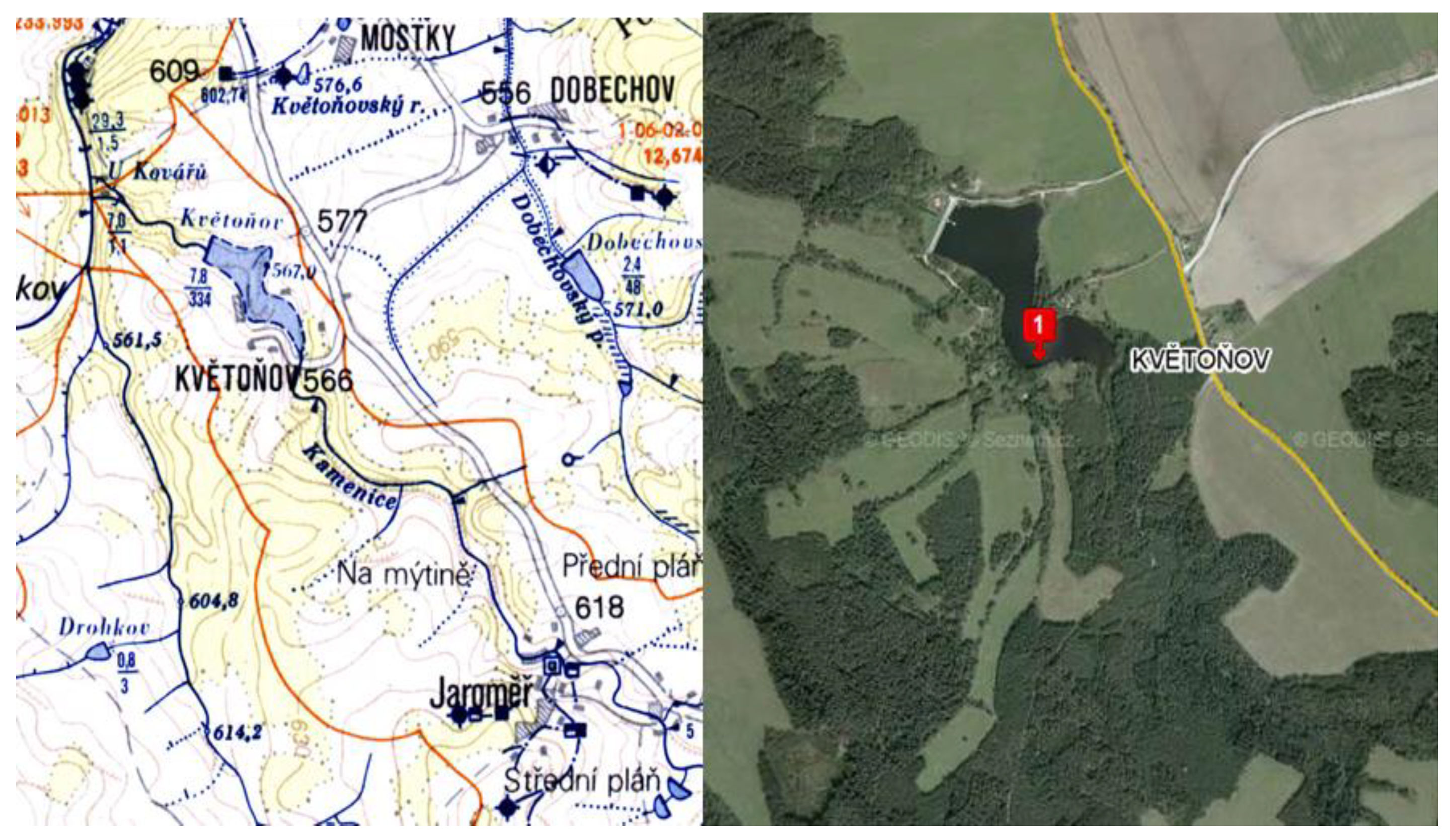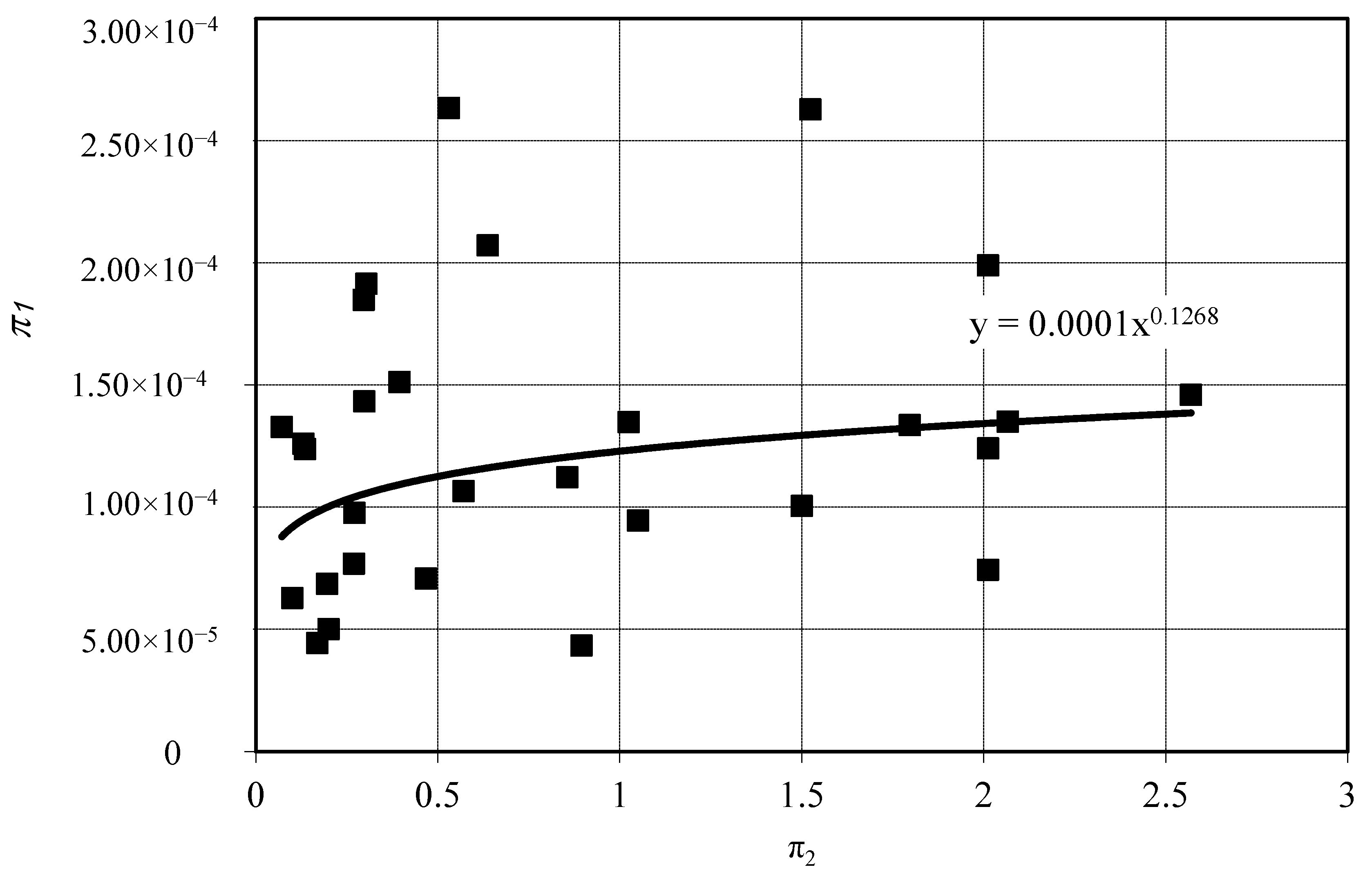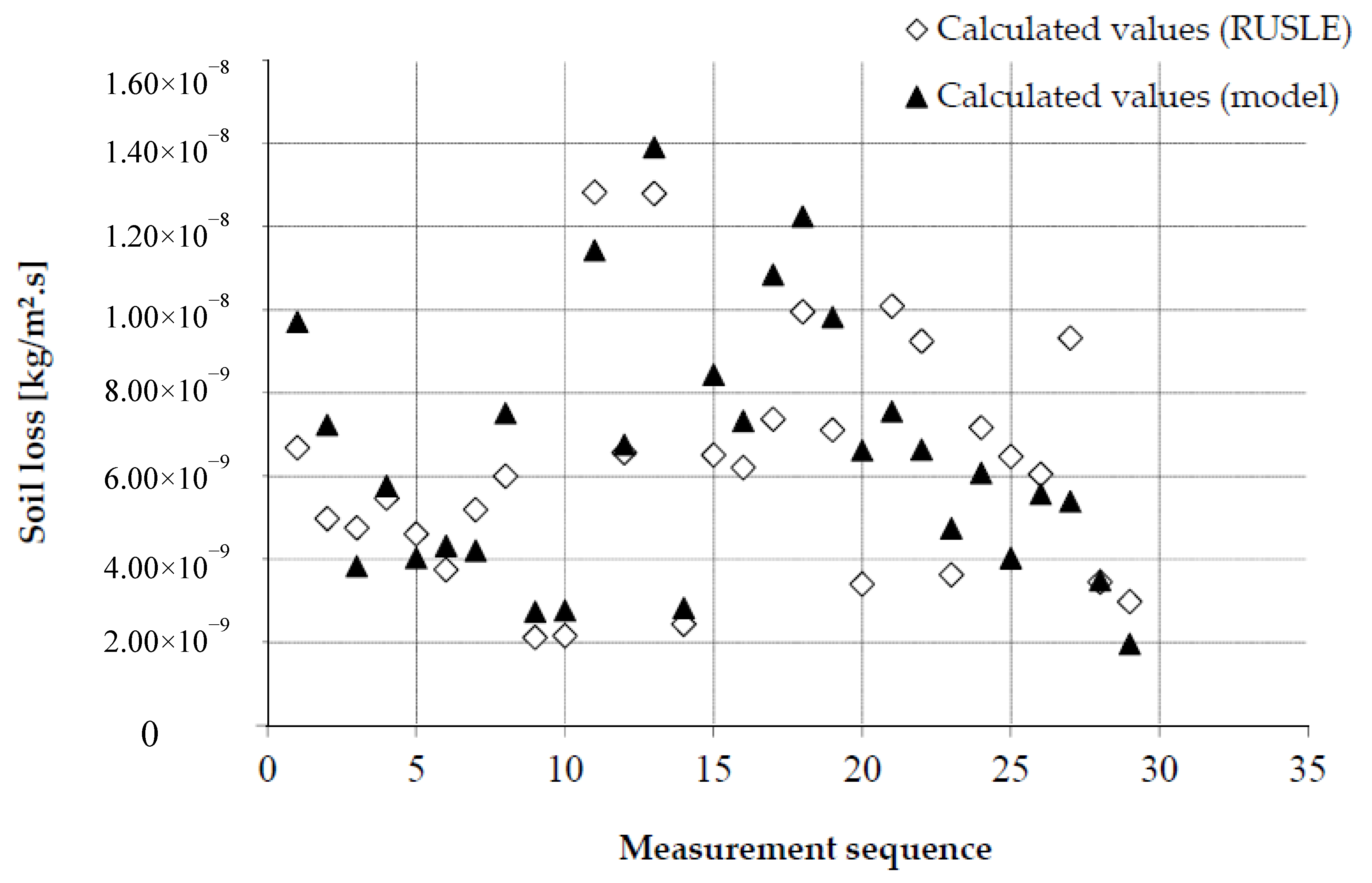Modelling of Erosion and Transport Processes
Abstract
1. Introduction
2. Materials and Methods
3. Results
| • Rainfall intensity | i | (m·s−1) |
| • Soil density | ρ | (kg·m−3) |
| • Area of the plot | S | (m2) |
| • Length of the plot | L | (m) |
| • Filtration coefficient | K | (m·s−1) |
| • Vegetation factor (from USLE) | C | (-) |
| • Coefficient of the slope steepness | Sf | (-) |
| • Soil loss (from plot) | O | [kg/(m2·s)] or (kg·m−2·s−1) |
4. Discussion
- No or low erosion is if O (t/ha/year) <4;
- Medium erosion is if O (t/ha/year) 4–8;
- High erosion is if O (t/ha/year) 8–12;
- Very high erosion is if O (t/ha/year) >12.
5. Conclusions
Author Contributions
Funding
Acknowledgments
Conflicts of Interest
References
- Zeleňáková, M.; Ondrejka Harbuľáková, V.; Karaszová, Z. Soil erosion risk in the catchment area of the water reservoirs. In Public Recreation and Landscape Protection–with Man Hand in Hand; Mendel University: Brno, Czechia, 2015; pp. 227–232. [Google Scholar]
- Alewell, C.H.; Borrelli, P.; Meusburger, K.; Panagos, P. Using the USLE: Chances, challenges and limitations of soil erosion modelling. Int. Soil Water Conserv. Res. 2019, 7, 203–225. [Google Scholar] [CrossRef]
- Phinzi, K.; Ngetar, N.S. The assessment of water-borne erosion at catchment level using GIS-based RUSLE and remote sensing: A review. Int. Soil Water Conserv. Res. 2019, 7, 27–46. [Google Scholar] [CrossRef]
- Ganasri, B.P.; Ramesh, H. Assessment of soil erosion by RUSLE model using remote sensing and GIS—A case study of Nethravathi Basin. Geosci. Front. 2016, 7, 953–961. [Google Scholar] [CrossRef]
- Prasannakumar, V.; Vijith, H.; Abinod, S.; Geetha, N. Estimation of soil erosion risk within a small mountainous sub-watershed in Kerala, India, using Revised Universal Soil Loss Equation (RUSLE) and geo-information technology. Geosci. Front. 2012, 3, 209–215. [Google Scholar] [CrossRef]
- Pham, T.G.; Degener, J.; Kappas, M. Integrated Universal Soil Loss Equation (USLE) and Geographical Information System (GIS) for soil erosion estimation in A Sap basin: Central Vietnam. Int. Soil Water Conserv. Res. 2018, 6, 99–110. [Google Scholar] [CrossRef]
- Addis, H.K.; Klik, A. Predicting the spatial distribution of soil erodibility factor using USLE nomograph in an agricultural watershed, Ethiopia. Int. Soil Water Conserv. Res. 2015, 3, 282–290. [Google Scholar] [CrossRef]
- Parsons, A.J. How reliable are our methods for estimating soil erosion by water? Sci. Total Environ. 2019, 676, 215–221. [Google Scholar] [CrossRef] [PubMed]
- Wischmeier, W.H.; Smith, D.D. Predicting Rainfall Erosion Losses. A Guide to Conservation Planning; Agriculture Handbook; U.S Department of Agriculture: Washington, DC, USA, 1978.
- Šlezingr, M.; Pilařová, P.; Pelikán, P.; Zeleňáková, M. Verification and proposal of the modification of “the method for the establishment of the erosion terminant”. Acta Univ. Agric. Silvic. Mendeleianae Brun. 2012, 60, 303–308. [Google Scholar] [CrossRef]
- Jakubíková, A. Using of RUSLE Software for Erosion Endangerment Determination in Condition of Czech Republic. Ph.D. Thesis, ČVUT, Praha, Czech Republic, 2004. (In Czech). [Google Scholar]
- Čarnogurská, M. Dimensional Analysis and Similarity Theory and Modelling in Practice; Elfa: Košice, Slovakia, 1998; p. 64. (In Slovak) [Google Scholar]
- Henriczy, G. Erosion and Transport Processes Evaluation by Using Geographical Information Systems. Bachelor’s Thesis, SvF TU, Košice, Slovakia, 2016. (In Slovak). [Google Scholar]
- Fulajtár, E.; Janský, L. Water Erosion of Soil and Erosion Protection; VÚPOP: Bratislava, Slovakia, 2001; p. 310. (In Slovak) [Google Scholar]
- Holý, M. Erosion and Environment; ČVUT: Praha, Czech Republic, 1994; p. 383. (In Czech) [Google Scholar]
- Heinige, V. Watershed Protection and Management; STU: Bratislava, Slovakia, 1995; p. 180. (In Slovak) [Google Scholar]



| Plot | S (m2) | L (m) | i (m/s) | ρ (kg/m3) | K (m/s) | C (−) | Sf (−) |
|---|---|---|---|---|---|---|---|
| 1 | 25,000 | 110 | 2.63 × 10−8 | 1880 | 4.0 × 10−6 | 0.005 | 1.7536 |
| 2 | 15,000 | 100 | 2.63 × 10−8 | 1880 | 4.0 × 10−6 | 0.005 | 1.3508 |
| 3 | 255,000 | 970 | 2.63 × 10−8 | 1850 | 7.0 × 10−6 | 0.610 | 1.0016 |
| 4 | 72,000 | 290 | 2.63 × 10−8 | 1850 | 7.0 × 10−6 | 0.610 | 1.4117 |
| 5 | 71,000 | 260 | 2.63 × 10−8 | 1850 | 7.0 × 10−6 | 0.005 | 1.1689 |
| 6 | 132,000 | 700 | 2.63 × 10−8 | 1850 | 1.5 × 10−5 | 0.610 | 0.7357 |
| 7 | 48,000 | 290 | 2.63 × 10−8 | 1850 | 7.0 × 10−6 | 0.610 | 1.0000 |
| 8 | 289,000 | 1460 | 2.63 × 10−8 | 1840 | 2.5 × 10−6 | 0.610 | 1.2113 |
| 9 | 29,000 | 180 | 2.63 × 10−8 | 1850 | 7.0 × 10−6 | 0.005 | 0.5712 |
| 10 | 53,000 | 560 | 2.63 × 10−8 | 1850 | 7.0 × 10−6 | 0.092 | 0.4778 |
| 11 | 65,000 | 350 | 2.63 × 10−8 | 1850 | 7.0 × 10−6 | 0.005 | 3.1411 |
| 12 | 59,000 | 240 | 2.63 × 10−8 | 1850 | 7.0 × 10−6 | 0.005 | 2.0019 |
| 13 | 39,000 | 160 | 2.63 × 10−8 | 1850 | 7.0 × 10−6 | 0.005 | 3.2743 |
| 14 | 50,000 | 500 | 2.63 × 10−8 | 1850 | 1.5 × 10−5 | 0.005 | 0.4544 |
| 15 | 46,000 | 160 | 2.63 × 10−8 | 1850 | 1.5 × 10−5 | 0.005 | 1.7730 |
| 16 | 118,000 | 950 | 2.63 × 10−8 | 1870 | 1.5 × 10−5 | 0.005 | 1.2783 |
| 17 | 54,000 | 370 | 2,63 × 10−8 | 1850 | 1.0 × 10−5 | 0.005 | 1.5781 |
| 18 | 34,000 | 130 | 2,63 × 10−8 | 1900 | 2.5 × 10−6 | 0.005 | 1.7536 |
| 19 | 37,000 | 120 | 2.63 × 10−8 | 1850 | 7.0 × 10−6 | 0.092 | 1.9745 |
| 20 | 245,000 | 620 | 2.63 × 10−8 | 1850 | 1.5 × 10−5 | 0.092 | 1.3735 |
| 21 | 60,000 | 450 | 2.63 × 10−8 | 1900 | 2.5 × 10−6 | 0.005 | 1.1689 |
| 22 | 34,000 | 130 | 2.63 × 10−8 | 1850 | 1.5 × 10−5 | 0.050 | 0.8440 |
| 23 | 126,000 | 650 | 2.63 × 10−8 | 1900 | 2.5 × 10−6 | 0.005 | 1.0294 |
| 24 | 412,000 | 2400 | 2.63 × 10−8 | 1850 | 7.0 × 10−6 | 0.092 | 1.2710 |
| 25 | 34,000 | 130 | 2.63 × 10−8 | 1850 | 7.0 × 10−6 | 0.005 | 1.5457 |
| 26 | 171,000 | 750 | 2.63 × 10−8 | 1850 | 7.0 × 10−6 | 0.005 | 1.8802 |
| 27 | 99,000 | 460 | 2.63 × 10−8 | 1850 | 7.0 × 10−6 | 0.005 | 1.1066 |
| 28 | 231,000 | 1520 | 2.63 × 10−8 | 1800 | 1.0 × 10−5 | 0.005 | 0.8188 |
| Plot | π1 | π2 | ORUSLE [kg/(m2·s)] | Omodel [kg/(m2·s)] | σ (%) |
|---|---|---|---|---|---|
| 1 | 1.35 × 10−4 | 2.066116 | 6.681 × 10−9 | 9.707 × 10−9 | 45.289 |
| 2 | 1.01 × 10−4 | 1.500000 | 4.975 × 10−9 | 7.234 × 10−9 | 45.413 |
| 3 | 9.77 × 10−5 | 0.271017 | 4.756 × 10−9 | 3.832 × 10−9 | 19.430 |
| 4 | 1.12 × 10−4 | 0.856124 | 5.466 × 10−9 | 5.764 × 10−9 | 5.450 |
| 5 | 9.46 × 10−5 | 1.050296 | 4.607 × 10−9 | 4.030 × 10−9 | 12.526 |
| 6 | 7.70 × 10−5 | 0.269388 | 3.748 × 10−9 | 4.322 × 10−9 | 15.316 |
| 7 | 1.07 × 10−4 | 0.570749 | 5.190 × 10−9 | 4.207 × 10−9 | 18.943 |
| 8 | 1.24 × 10−4 | 0.135579 | 5.999 × 10−9 | 7.512 × 10−9 | 25.220 |
| 9 | 4.34 × 10−5 | 0.895062 | 2.115 × 10−9 | 2.735 × 10−9 | 29.326 |
| 10 | 4.44 × 10−5 | 0.169005 | 2.162 × 10−9 | 2.768 × 10−9 | 28.018 |
| 11 | 2.63 × 10−4 | 0.530612 | 1.282 × 10−8 | 1.142 × 10−8 | 10.940 |
| 12 | 1.35 × 10−4 | 1.024306 | 6.567 × 10−9 | 6.756 × 10−9 | 2.885 |
| 13 | 2.63 × 10−4 | 1.523438 | 1.279 × 10−8 | 1.391 × 10−8 | 8.688 |
| 14 | 5.01 × 10−5 | 0.200000 | 2.438 × 10−9 | 2.826 × 10−9 | 15.908 |
| 15 | 1.34 × 10−4 | 1.796875 | 6.506 × 10−9 | 8.435 × 10−9 | 29.639 |
| 16 | 1.26 × 10−4 | 0.130748 | 6.202 × 10−9 | 7.322 × 10−9 | 18.054 |
| 17 | 1.51 × 10−4 | 0.394490 | 7.366 × 10−9 | 1.084 × 10−8 | 47.202 |
| 18 | 1.99 × 10−4 | 2.011834 | 9.953 × 10−9 | 1.224 × 10−8 | 23.033 |
| 19 | 1.46 × 10−4 | 2.569444 | 7.109 × 10−9 | 9.828 × 10−9 | 38.248 |
| 20 | 2.07 × 10−4 | 0.637357 | 1.008 × 10−8 | 7.553 × 10−8 | 25.118 |
| 21 | 1.85 × 10−4 | 0.296296 | 9.243 × 10−9 | 6.634 × 10−9 | 28.224 |
| 22 | 7.44 × 10−5 | 2.011834 | 3.624 × 10−9 | 4.742 × 10−9 | 30.850 |
| 23 | 1.43 × 10−4 | 0.298225 | 7.166 × 10−9 | 6.073 × 10−9 | 15.250 |
| 24 | 1.33 × 10−4 | 0.071528 | 6.468 × 10−9 | 4.026 × 10−9 | 37.753 |
| 25 | 1.24 × 10−4 | 2.011834 | 6.043 × 10−9 | 5.566 × 10−9 | 7.898 |
| 26 | 1.91 × 10−4 | 0.304000 | 9.322 × 10−9 | 5.385 × 10−9 | 42.235 |
| 27 | 7.09 × 10−5 | 0.467864 | 3.450 × 10−9 | 3.495 × 10−9 | 1.304 |
| 28 | 6.29 × 10−5 | 0.099983 | 2.980 × 10−9 | 1.957 × 10−8 | 34.324 |
© 2019 by the authors. Licensee MDPI, Basel, Switzerland. This article is an open access article distributed under the terms and conditions of the Creative Commons Attribution (CC BY) license (http://creativecommons.org/licenses/by/4.0/).
Share and Cite
Zeleňáková, M.; Harabinová, S.; Mésároš, P.; Abd-Elhamid, H.; Purcz, P. Modelling of Erosion and Transport Processes. Water 2019, 11, 2604. https://doi.org/10.3390/w11122604
Zeleňáková M, Harabinová S, Mésároš P, Abd-Elhamid H, Purcz P. Modelling of Erosion and Transport Processes. Water. 2019; 11(12):2604. https://doi.org/10.3390/w11122604
Chicago/Turabian StyleZeleňáková, Martina, Slávka Harabinová, Peter Mésároš, Hany Abd-Elhamid, and Pavol Purcz. 2019. "Modelling of Erosion and Transport Processes" Water 11, no. 12: 2604. https://doi.org/10.3390/w11122604
APA StyleZeleňáková, M., Harabinová, S., Mésároš, P., Abd-Elhamid, H., & Purcz, P. (2019). Modelling of Erosion and Transport Processes. Water, 11(12), 2604. https://doi.org/10.3390/w11122604








